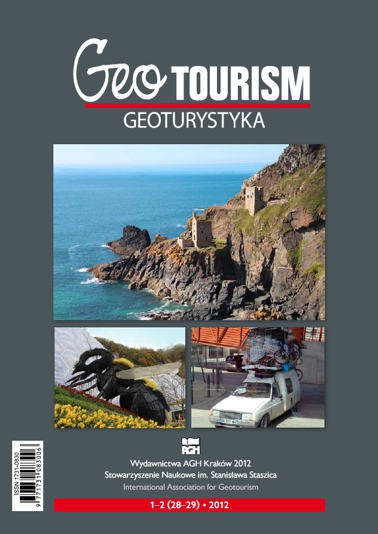A trail of storms imprinted in Triassic rocks on the touristic path: an example from Grodziec (Dąbrowa Basin, southern Poland)
DOI:
https://doi.org/10.7494/geotour.2012.28-29.51Słowa kluczowe:
Upper Silesia, Dąbrowa Basin, Grodziec, Triassic carbonate sediments, storm activityAbstrakt
The Upper Silesia – Dąbrowa Basin is one of the highest industrially transformed regions in Europe. However, places of geotouristic value are still preserved and should be protected. One of them is the abandoned “Kamionka” quarry and nearby St. Dorota hill, known as “local Olympus” with historical monuments, located in the Grodziec district of Będzin. The profile of Triassic limestones, dolomitized limestones and marly dolomites belong to so called Gogolin Beds and represent the sedimentation typical of sea transgression with numerous changes in water energy, up to stormy sedimentation, imprinted in rock textures and sedimentary structures. Both proximal and distal tempestites are found here. Local bioturbations are indicative for breaks in storm activity and low-energy sedimentation. In general, the carbonate sediments of Grodziec district were formed in shallow basin, on the carbonate ramp, influenced by storms and/or bottom currents. The link between the history of that area, geomorphology and geological features makes that area of special importance for geotourism.Pobrania
Bibliografia
Aigner, T., 1985. Storm depositional systems. In: Lecture Notes in Earth-Science 3, Berlin-Springer.
Assman, P., 1944. Die Stratigraphie der Oberschlesichen Trias; Teil 2. Der Muschelkalk. Abhandlungen. Reichsamts für Bodenforschfung, Neue Folge, 208: 1–124.
Błaszczyk, W., 1982. Będzin przez wieki. Dzieje miasta i jego rozwoju urbanistyczno-przestrzennego od średniowiecza do połowy XX wieku na podłożu osadnictwa w starożytności i wczesnym średniowieczu. PTTK, Poznań 1982.
Chudzikiewicz, L., 1975. Intraformational conglomerates in the Gogolin Beds (Middle Triassic, southern Poland). Rocznik PTG, 45: 3–20.
Duke, W.L., 1985. Hummocky cross-stratification, tropical hurricanes, and intense winter storms. Sedimentology, 32: 167–194.
Flügel, E., 2004. Microfacies of Carbonate Rocks. Analysis, Interpretation and Application. Springer.
Gradziński, R., 1972. Przewodnik geologiczny po okolicach Krakowa. Wydawnictwa Geologiczne, Warszawa.
Goszcz, A., 1982. Systemy uskoków normalnych w rejonie Będzina, Czeladzi i Wojkowic Komornych oraz orientacja pól naprężeń tektonicznych powodujących powstanie tych uskoków. Przegląd Geologiczny, 7: 374–376.
Pawłowska, J., 1985. Rozwój facjalny morskich utworów triasu na obszarze śląsko-krakowskim. Biuletyn Instytutu Geologicznego, 349: 41–88.
Różkowski, A., Chmura, A., 1996 (red.). Mapa dynamiki zwykłych wód podziemnych GZW i jego obrzeżenia. Skala 1: 100 000. Państwowy Instytut Geologiczny.
Senkowiczowa, H., 1980. Możliwości sformalizowania podziału litostratygraficznego środkowego i górnego triasu Wyżyny Śląsko-Krakowskiej. Kwartalnik Geologiczny, 24, 4: 787–804.
Siedlecki, S., 1952. Utwory geologiczne między Chrzanowem a Kwaczałą. Biuletyn Instytutu Geologicznego, 60: 5–230.
Szulc, J., 2000. Middle Triassic evolution of the northern Peri-Tethys area as influenced by early opening of the Tethys Ocean. Annales Societatis Geologorum Poloniae, 70: 1–48.
Vierek, A., 2007. Storm-dominated deposition on a Frasnian carbonate platform margin (Wietrznia, Holy Cross Mts., Poland). Geological Quarterly, 51, 3: 307–318.



